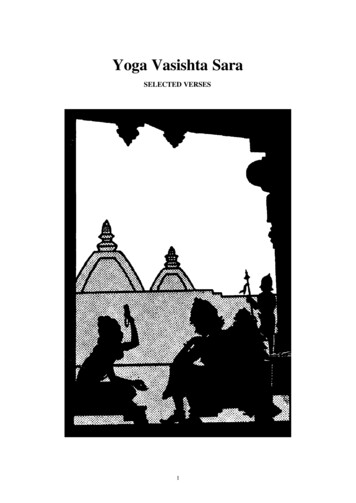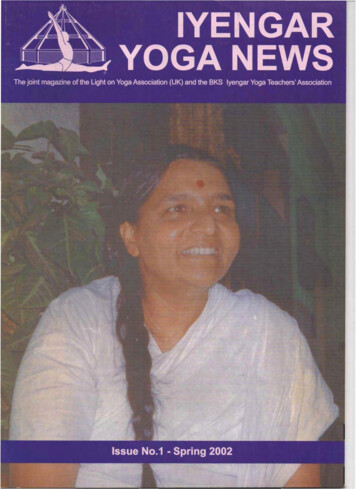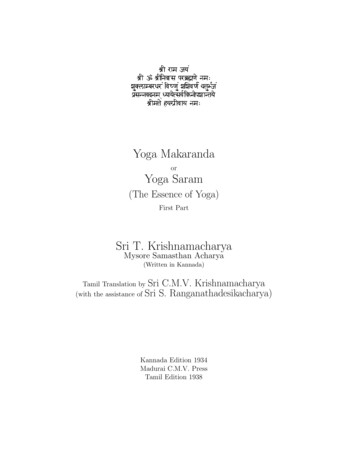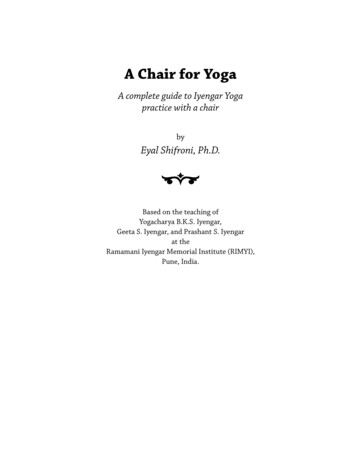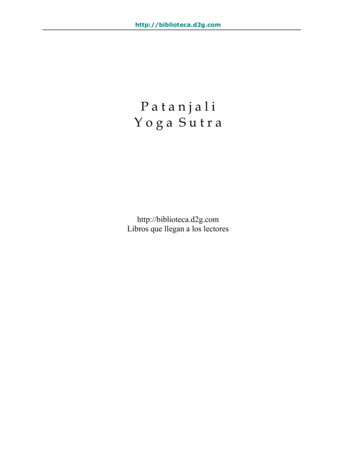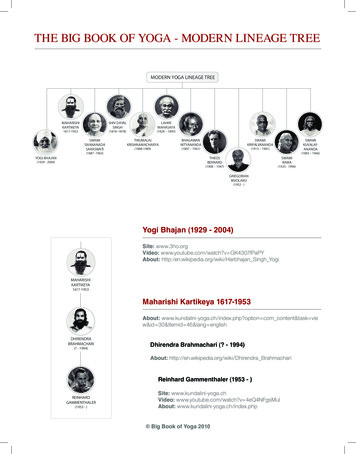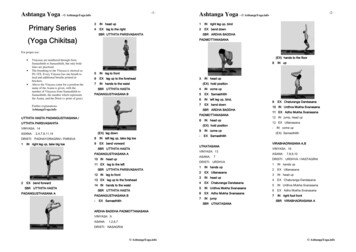
Transcription
Yoga Vasishta by ValmikiThe original Sanskrit attributed to Sage Valmikitranslated to English by Vihari Lala Mitra (1891)edited by Thomas L. Palotas (2013)Publisher: Handloom PublishingShivabalayogi Seva FoundationP.O. Box 64634, Tucson, Arizona U.S.A. 85728Shri Shivabalayogi Maharaj International Trustwww.shivabalayogi.orgSummary Table of ContentsGlossaryThe Stories in Yoga VasishtaIntroductionBook I — On DetachmentBook II — The Aspirant Who Longs for LiberationBook III — On CreationBook IV — On ExistenceBook V — On Dissolution, Becoming QuietBook VI, Part 1 — On LiberationBook VI, Part 2 — The Latter TreasuryDedicated to His Holiness, Shri Shri Shri Shivabalayogi Maharaj.
His Holiness Shri Shri Shri Shivabalayogi Maharaj described Yoga Vasishta as the best spiritualtreatise, being the least altered over time. He would not admit to being Vasishta himself, but he saidhe was present when Vasishta answered Rama’s questions and evoked Rama’s Self realization.
GLOSSARYagnishtoma — an ancient Vedic ceremony performed by a brahmin desirous of obtaining heaven. Theceremonies continue for five days with sixteen priests officiating.akshauhini — an ancient battle formation of 21,870 chariots, 21,870 elephants, 65,610 cavalry, and109,350 infantry.Agastya — considered a Tamil/Vedic sage is one of the Seven Sages ( Saptarishi). He is creditedwith many mantras of the Rig Veda, and is also the author of Agastya Samhita (Agastya Collection).Once a clan of demons hid in the Cosmic Ocean so the gods could not defeat them. The gods appealedto Agastya who drank the entire ocean and held it within until the demons were destroyed.amalaki — (Emblica Officinalis) Indian gooseberry, a small tree whose fruit, in Ayurvedic healingtradition, is considered the most powerful rejuvenating medicine.Amaravati — the heavenly city of Indra, King of the Gods.apsara — beautiful, supernatural women; nymphs. They are youthful and elegant, and proficient in theart of dancing. They are the wives of the gandharvas, the court servants of Indra, the Lord of the Gods.They dance to the music made by their husbands, usually in the palaces of the gods, and entertain godsand fallen heroes.arghya — an offering of water as a token of respect.Aruna — the god who serves as the charioteer of the Sun.Arundhati — The wife of Vasishta.asura — power-seeking deities, sometimes considered sinful and materialistic.ativahika — In the Upanishads, refers to those who are deployed to carry the dead to the other world.Here, the meaning is the everlasting spiritual body.Ayodhya — the capital of Kosala, the kingdom ruled by Dasharata.bael — the bael (bel, bilva, wood apple) tree is considered sacred to Shiva. Its fruit, as large as agrapefruit, has a smooth, woody shell so hard it must be cracked with a hammer. The fibrous yellowpulp inside is very aromatic.Bali — (Mahabali, Great Bali) an asura demon, was the son of Devamba and Virochana. He grew upunder the tutelage of his grandfather, Prahlada, who instilled in him a strong sense of righteousnessand devotion. Bali would eventually succeed his grandfather as the king of the asuras, and his reignwas characterized by peace and prosperity. He would later expand his realm and bring the entireworld under his benevolent rule. He was even able to conquer the underworld and heaven, which hewrested from Indra and the gods.Bhairava — fierce, destructive manifestations of Shiva.Bharadwaja — a sage, one of the even rishis, the leading student of Valmiki, and considered theancestor of all brahmins.Bharata — (“Emperor”) legendary ruler of India after whom India and Indians are named.Brahma — God the Creator, also the father of Vasishta.
Brahma rishi — the highest class of rishis (sages), one who has understood the meaning of Brahman,the highest divine knowledge.Brahmaloka — the heavenly world where Brahma resides.Brahman — the indescribable One.brahmin (fem. brahmani) — members of the priestly caste.Brihaspati — Sage and guru to the gods; identified with the planet Jupiter.chandala — a man born of the illegal union of a low caste shudra man with a woman of one of thethree higher castes. They were regarded as the vilest and most abject of the men.chandrayana — a penance, including fasting, according to the lunar cycle.Charvaka — a system of Indian philosophy that dates back to the 7th C. BCE, around the same timeas Buddhism and Jainism became popular. It assumes skepticism and religious indifference and ischaracterized as a materialistic and atheistic school. Charvakas believe only what the physical sensestangibly perceive.chataka — a kind of cuckoo (Cuculus Melanoleucus). Indian traditions suppose that it drinks onlythe water of the clouds, and their poets usually introduce allusions to this bird in connection withcloudy or rainy weather.chauri — a female hybrid of yak and hill cattle.Chitragupta — the god assigned to the task of keeping complete records of actions of human beings.daivam — fate, providence, god.dakini — in Indian tradition, female demons, vampires, and blood-drinkers feeding on human flesh. Intantric practice, she is a female embodiment of enlightened energy.dakshinayana — The sun’s yearly movement is divided into two parts, uttarayana anddakshinayana. Uttarayana starts with the winter solstice and dakshinayana starts with the summersolstice.Danava — a race of asuras, demi-gods.Dasharata — King of Kosala ruling from its capital of Ayodhya, and father of Rama.dvijas — the three higher castes: brahmins (priests), kshatriyas (rulers and warriors) and vaishyas(traders and landowners). The second birth relates to assuming their roles in society.eight elements — the eight basic elements are earth, water, fire, air, space, mind, intellect andidentity. The first five elements are the gross aspects of matter, and the last three are the subtleaspects of matter.five elements — earth, water, fire, air, space (akasha).fourteen worlds — lokas or dimensions. The seven higher (heavens) lokas are: the three planes inwhich the gods live: satya (truth, the highest); tapas (spiritual austerities; meditation in samadhi); andjnana (creative, knowledge); mahar (spiritual masters), svar (heaven of Indra); bhuvar (demigods);and bhu (material world, the earth). The lower ones (the “seven underworlds” or patalas) are atala,vitala, sutala, rasaataala, talatala, mahaatala, paatala.
gandharva — male nature spirits, husbands of the apsaras. Some are part animal, usually a bird orhorse. They have superb musical skills and made beautiful music for the gods in their palaces.garima — one of the siddhis (powers) acquired through yoga in which the yogi swallows andcompresses great draughts of air.garuda — a lesser deity, part man and part eagle, known as the eternal sworn enemy of the naagaserpent race. His image is often used as the charm to protect the bearer from snake attack and poison,and the garudi vidya is a mantra to remove snake poison and all other kinds of evil.Gauri — “Golden”, a name of Goddess Parvati, considered the spouse of God Shiva.gunas — Three primary gunas are the fundamental qualities or operating principles in creation:sattvas (purity, balance, preservation), rajas (action, creation, power) and tamas (lethargy, passivity,destruction).Hara — name of Shiva meaning Destroyer (i.e., the destroyer of illusion).Hari — name of Vishnu meaning Tawny (yellowish-brown) or Remover.hatha yoga — has the meaning of forceful yoga. It is a system of physical exercises to promote healthand prepare the body for long meditation. It is what most people in the West association with theword yoga.ichor — fragrant secretion from a rutting elephant’s temples.Indra — King of the gods; his vehicle is Airavat, the eight trunked elephant.jagat — “all that moves”, the created universe.Janaka — Self realized King of Videha and father of Sita, the wife of Rama.jiva — the individual soul. The root meaning of jiva is to breathe, which implies movement. TheLatin vivus (alive) shares the same Indo-European origin.kaivalya — Absolute oneness, aloneness; perfect detachment, freedom. Kaivalya is the term used inthe yoga tradition to name the goal and fulfillment of yoga, the state of complete detachment fromrebirth.kalpa — 4,320,000,000 years. Two kalpas are a day and night of Brahma.kalpa tree — mythical wish-fulfilling tree.Kama — the god of love, as in lust.Kapali — “Skull-bearer”, a name of Goddess and a reference to sadhus (ascetics, holy men) whoworship God in this form.kinnara — the paradigm of a lover, a celestial musician, half-human and half-horse.Kirata — the Kirat are indigenous ethnic groups of the mid-hills of the Himalayas, extendingeastward from Nepal into India, Burma and beyond. Kirata is a general reference to peoples of theHimalayan foothills in India, i.e., Mongol-type peoples.Kosala — the kingdom ruled by Dasharata.kshetrajna — a compound of kshetra (body) and -jna (knower). Because what one knows
encompasses the field of one’s sphere of action, it could be translated as field-knower, or witnessconsciousness.kumbhaka breathing — an advanced practice of breath control (pranayama) to regulate the mindand increase concentration.kusa (kusha) grass — a long, sharp edged grass considered sacred and used to cover a meditationseat.Lakshman — Rama’s brother.Lakshmi — goddess of abundance, wealth; considered the spouse of God Vishnu.linga deha — the subtle or astral body.loka — world, dimension, environment. Variously numbered three or fourteen.Lokaloka — world and no world, a magnificent belt of mountains girdling the outermost of the sevenseas and dividing the visible world from the region of darkness.Mahadeva — “Great God”, a name of Shiva.Mandakini — a sacred river that flows from near Kedarnath in the Himalayas into the Ganges. Thecelestial Mandakini River is the Milky Way.mandara (flower) — Datura stramonium, a flower considered sacred to the gods and often plantedby temples.Mandara Mountain — mythical mountain used by the gods and demons to churn the milky sea andseparate the nectar of immortality from the poison.manvantara — an age of Manu, the first man in Indian cosmology. Fourteen such lifetimes make akalpa, a day of Brahma.Meru (Sumeru) — mythical mountain considered to be the center of the universe, around which thesun, moon, planets and stars revolve.moksha — release from the cyclical flow of birth, life, death and rebirth.muni — an ancient rishi.nag, naag — a divine snake or cobra; races of such beings.Nandana — garden of paradise.Narada — an ancient sage devoted to Vishnu. Narada is the guru of Valmiki.Narasimha — the half-man, half-lion major avatar of Vishnu. He was created to destroy the demonHiranyakashipu and not upset the boon given by Brahma, that Hiranyakashipu could not be killed by ahuman, a god, or an animal. Narasimha’s nature is that of divine anger.Narayana — God Vishnu resting on waters, or on the coiled form of Sesa-naaga, the endless serpent.Narayana is associated with Brahma the Creator as well as Vishnu the Sustainer.nirvikalpa samadhi — formless samadhi in which there is no longer any sense of individual identityand no thought; the ultimate Self realization.pisacha — the fading remnant of a human being, considered to be a malevolent astral being.
prana — vital energy (literally, airs), the subtle life force that circulates in the channels (nadis) of theastral (subtle) body and associated with the breath but more subtle. Comparable to Chinese chi (qi).pranava yoga — the controller of life force (prana, vital breath) is the sound Om (sometimes spelledAum) the most sacred word in yoga. Meditation on the sound of Om is pranava yoga.pranayama — the science of breath (life force, prana) control.Puranas — a genre of important Indian religious texts, myths and histories, from c. 200-1500 AD.pushkaravarta — (from pushkara, water, and vrita, to have place in, i.e., a watery cloud) a namefor the flood clouds of the world-destroying deluge.Raghava, Raghu — the dynasty of King Dasharata and Rama.raja yoga — the king of yoga because its practices focus on controlling the mind, which controls theindividual ego. It consists of a series of practices that culminates in meditation without form focusedbetween the eyebrows.rajas — the quality of action or force; one of the three gunas.rajasuya — a sacrifice performed by the ancient kings of India who considered themselves powerfulenough to be an emperor. Rajasuya would occur after the king’s generals returned from a successfulmilitary campaign. The ceremony was religious and political because it implied that he who institutedthe sacrifice was a supreme lord, a king over kings, and his tributary princes were required to bepresent at the rite.rakshasa (fem. rakshasi) — supernatural humanoids, some good and others malicious. They arepowerful warriors, expert magicians, illusionists and shape-changers.Rama — A major incarnation (avatar) of God Vishnu. He was born, in part, because of a curse byAnaranya, Rama’s ancestor, against Ravana. When Ravana subjugated Anaranya, the dying Anaranyacursed Ravana to die at the hands of his great-grandson (Rama) in later generations.Ramayana — the epic story, some 24,000 verses (slokas), of the life of Rama attributed to sageValmiki. With the Mahabharata, it forms the two great epic stories of Hindu culture. Ramayana canalso refer to the Yoga Vasishta as its full title is the Yoga Vasishta Maharamayana.Rati — one of the two wives of Kama, the god of love.Ravana — the ten-headed rakshasa demon King of Lanka and antagonist of Rama. He was born of abrahmin father and a daitya rakshasa mother. Ravana performed tapas to God Brahma, chopping offhis own head ten times to appease the god. He became an ardent devotee of Lord Shiva.rishi — one who speaks the truth; an ancient sage.Rudra — an ancient name of Shiva. The Rudras are forms and followers of Rudra-Shiva, eleven innumber. The Rudras are described as the loyal companions or messengers of Shiva, often fe
Yoga Vasishta by Valmiki The original Sanskrit attributed to Sage Valmiki translated to English by Vihari Lala Mitra (1891) edited by Thomas L. Palotas (2013) Publisher: Handloom Publishing Shivabalayogi Seva Foundation P.O. Box 64634, Tucson, Arizona U.S.A. 85728 Shri Shivabalayogi Maharaj International Trust www.shivabalayogi.org Summary Table of Contents Glossary The Stories in Yoga .
